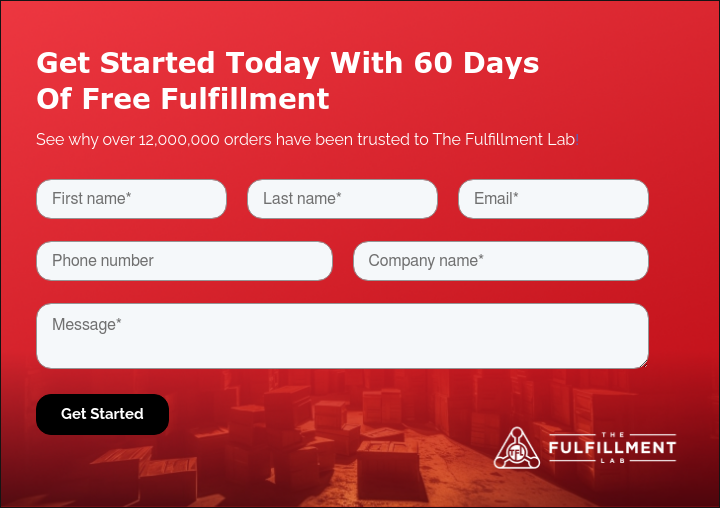What Is Pick, Pack, And Ship? Streamline Your Warehouse Process
Fast, accurate order fulfillment is the backbone of successful eCommerce. Customers expect quick delivery, minimal errors, and a smooth experience from checkout to doorstep. As a seller, your profits depend on shipping as many correct orders as possible, without sacrificing speed or customer satisfaction.
That’s why the pick, pack, and ship process is so important. This three-step workflow ensures products are located in the warehouse (pick), prepared safely and accurately (pack), and delivered to the customer (ship). Simple in theory, but efficiency at each stage can make or break your fulfillment operation.
In this guide, we’ll break down each step of the pick, pack, and ship process, outline best practices, and share strategies that help reduce delays, lower costs, and improve accuracy at every stage.
Step 1: Pick - Find Products Faster
Once a customer orders an item from your store, your warehouse workers need to find what your customer purchased. This process is tougher when you’re working with a large inventory. So, many warehouses use a warehouse management software (WMS) tool to help them find items fast.
Effective picking techniques are crucial in saving time, money, and labor. On average, order picking accounts for 55% of a warehouse worker’s labor time. By decreasing the amount of time a worker spends picking every single order, you can decrease that 55% and give them more time for other duties.

Whether you use a WMS or not, you should follow these tips to streamline the “pick” stage. Help your “pickers” by giving them:
- Handheld barcode scanners that help them pinpoint the exact product.
- A detailed map of the warehouse that shows where you store different item types (e.g. shoes are in this section, pants in another section, etc.)
- Strategically organized items, for example, put your most popular items in an easy-to-find location.
- Picking routes that decrease the amount of time workers spend wandering your warehouse. You can mark them on the warehouse map.
- Easy access to a sufficient number of pallets or containers so pickers can retrieve more items in less time.
- Picking strategies that boost productivity in each scenario.
Now, let’s dig a bit deeper into picking strategies. Choosing the wrong strategy for an order is one of the most common culprits behind warehouse inefficiency. Consider how to use the following strategies.

Credit: Pexels
Piece Picking
Piece picking is the most common and straightforward method. It’s when your picker travels to the item’s location, pulls it off the shelf, and carries it out. Similar to how you might find something at the grocery store. This works for small orders, but it can be inefficient for larger batches.
Discrete Picking
Discrete picking is a lot like piece picking. A piece picker picks one item at a time and may work on multiple orders. Whereas, a discrete picker picks one item for one order at a time. This is time-consuming but very accurate. It’s good for high-value items that need perfect accuracy.
Batch Picking
Batch picking reduces the amount of time your picker spends locating items. Batch pickers collect items for multiple orders at the same time. It’s a good choice for items located near the back of your warehouse. Batch pickers typically use hand carts or pallets to carry items.
Wave Picking
Also known as cluster picking, wave picking occurs when pickers are scheduled to collect orders in intervals. These intervals are your “waves.” Typically, pickers collect items for 3-12 orders per interval. It’s good for suppliers that get several high volume orders per day.
Zone Picking
Zone picking is also referred to as the “pick and pass” method. It’s when you divide your warehouse into specific zones and assign pickers to each zone. You can train your pickers to become specialists in their assigned zone. This helps reduce time spent locating items.
Part-to-Picker
Part-to-Picker is the fastest picking method. It’s when a machine automatically brings the item to the worker. Usually, pickers stay near the packing station so they can quickly deliver items. However, these machines are expensive to implement.
Combined Picking
If required, combine the strategies listed above. For example, zone-batch picking assigns the picker to a specific zone and instructs them to batch pick all orders from that zone. Zone-batch-wave picking does the same in scheduled intervals.
You can combine any picking methods—just make sure it’s clear to your pickers how you want them to pick.
Step 2: Pack - Prepare Orders For Shipment
After locating everything on your picking list, you must pack these items before shipping. Often, employees at your warehouse pick and pack the items for you. So, remember to provide them with sufficient packing materials too.
The right packaging does more than protect your products, it can lower shipping costs and leave a lasting impression on customers. Use appropriately sized boxes to reduce dimensional (DIM) weight charges from carriers. Oversized packaging not only wastes space but can also increase shipping rates.
Consider using branded or custom packaging to boost your unboxing experience and brand recall. This small detail can turn one-time buyers into loyal customers. And for businesses looking to reduce their environmental impact, recyclable or biodegradable packing materials can support sustainability goals without compromising performance.
Both processes can occur at the warehouse, but pickers and packers aren’t usually the same people. Once the picker locates the items, they forward them to the packing station. Like picking strategies, it’s important to choose the right packaging for each order, from corrugated boxes to plastic boxes.
You should also include a packing slip with each order. Packing slips help packers understand what needs to be packed, and customers use them to check that what they ordered is there. Packing slips must include:
Customer Address & Contact Info
Your shipping label will include this information, but you should also include it on your packing slip as backup.
List Of Items & The Quantity Of Each Item
Customers like cross-referencing their orders with your slips.
Out-Of-Stock Items That Were Ordered But Not Fulfilled
Always notify the customer ahead of time in this situation. However, it’s a good practice to have it in writing on the packing slip too.
Each Item’s SKU Or UPC Number
This is what you use to track inventory and reference the specific item if there are any issues.
Slip Or PO Number
This helps you and your customer verify that the right order went to the right person.
You may also add a personalized message to your slip. This is not a must-have, but it helps build brand loyalty. Packing slips may also be used by your pickers to fulfill orders.
Step 3: Ship - Calculate The Costs
At this point, it may be tempting to think the work is over. The biggest thing you must remember is to calculate the cost of shipping before you send out your package.
Calculating in advance prevents you and the customer from seeing any surprise charges. For example, some countries have duty fees that you need to plan around. Other factors that increase shipping costs are:
- Weight
- Dimensional size
- Priority shipping
- Value of content
- Shipping zone (for example, see FedEx’s shipping zones)
Choose The Right Carrier For Speed & Reliability
Not all carriers are the same, and choosing the wrong one can lead to missed delivery windows, higher costs, or poor customer reviews. Evaluate your shipping zones, average order size, and required delivery speed when selecting a carrier. Many businesses partner with multiple providers to balance cost-effectiveness with fast delivery.
If you ship internationally, be sure to check for any customs requirements, duties, or special documentation needed to prevent delays.
Offer Tracking & Clear Communication
Today’s shoppers expect to track their orders every step of the way. Make sure each shipment includes a tracking number, and notify your customers once their order is in transit. Real-time shipping updates help reduce customer service inquiries and build trust.
Don’t Overlook The Returns Process
Returns are a natural part of online retail, so your shipping strategy should include a simple and transparent return process. Include a printed return label if possible, or offer a hassle-free digital return portal. A clear policy reassures customers and reduces friction if something goes wrong.
Pick Pack And Ship Process FAQ
What Causes Delays In The Pick, Pack, And Ship Process?
Common causes include disorganized inventory, poor warehouse layout, lack of automation, and unclear picking strategies. Streamlining each step with the right tools and processes helps reduce fulfillment time.
How Do I Scale Pick-Pack-Ship As Order Volume Grows?
Scaling requires strong warehouse management software, optimized picking routes, and enough staff during peak times. Outsourcing to a 3PL like The Fulfillment Lab can also help you scale quickly without adding internal complexity.
Can I Automate The Pick, Pack, And Ship Process?
Yes, many fulfillment centers use automation tools such as barcode scanners, robotic pickers, and real-time inventory management software to improve speed and accuracy. The Fulfillment Lab integrates all of these to deliver reliable, fast order processing.
Simplify The Pick Pack & Ship Proccess With Inventory Management
You can’t fully utilize the pick, pack, and ship method without the right inventory management techniques. At The Fulfillment Lab, we take care of all of that for you—from kit assembly, to picking, packing, and shipping. All with a guaranteed 3-day delivery.
This includes raw materials, finished goods, and warehousing. Pick and pack shipping will make order fulfillment more efficient, but it can only do so much without proper inventory management.
Simplify your shipping even further when you connect your fulfillment services to your eCommerce platform with the power of The Fulfillment Lab’s software.
Improve supply chain management by seamlessly managing orders, tracking inventory, customizing packages, and making last-minute edits.
Contact us to make your pick-pack-ship procedure even more efficient!


